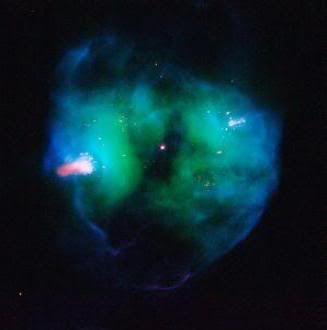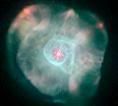Post by glactus on Mar 7, 2008 4:26:48 GMT

Probing a glowing bubble of gas and dust encircling a dying star, NASA's Hubble Space Telescope reveals a wealth of previously unseen structures.
The object, called NGC 2371, is a planetary nebula, the glowing remains of a Sun-like star. The remnant star visible at the center of NGC 2371 is the super-hot core of the former red giant, now stripped of its outer layers. Its surface temperature is a scorching 240,000 degrees Fahrenheit. NGC 2371 lies about 4,300 light-years away in the constellation Gemini.
The Hubble image reveals several remarkable features, most notably the prominent pink clouds lying on opposite sides of the central star. This color indicates that they are relatively cool and dense, compared to the rest of the gas in the nebula.
Also striking are the numerous, very small pink dots, marking relatively dense and small knots of gas, which also lie on diametrically opposite sides of the star. These features appear to represent the ejection of gas from the star along a specific direction.
The jet's direction has changed with time over the past few thousand years. The reason for this behavior is not well understood, but might be related to the possible presence of a second star orbiting the visible central star.
In only a few thousand years the nebula will dissipate into space. The central star will then gradually cool down, eventually becoming a white dwarf, the final stage of evolution for nearly all stars.

IC 4593
credits;
This article was adapted from materials provided by the Space Telescope Science Institute.
This is part text only. See image, full text and all scientists involved at sciencedaily.com
www.sciencedaily.com/releases/2008/03/080304125346.htm



